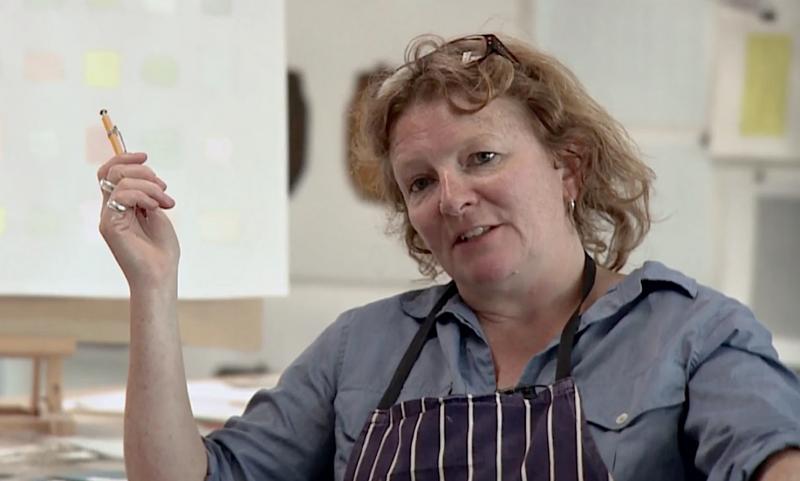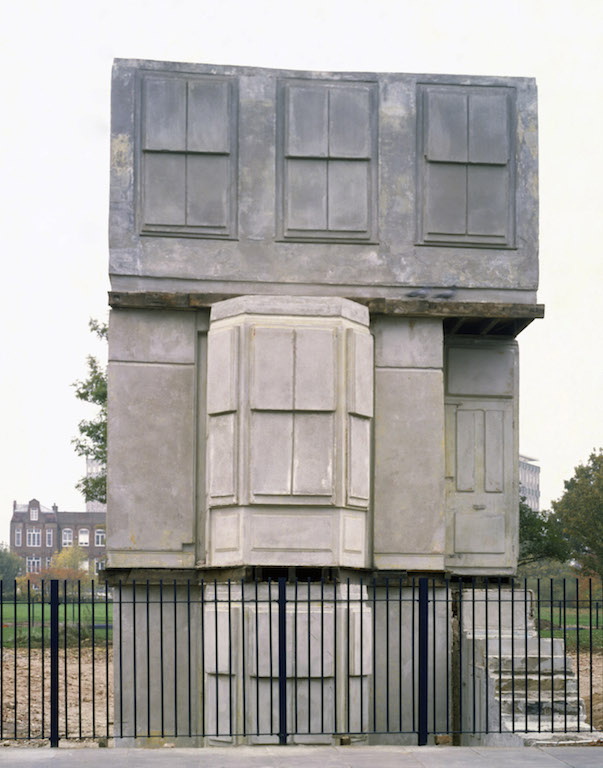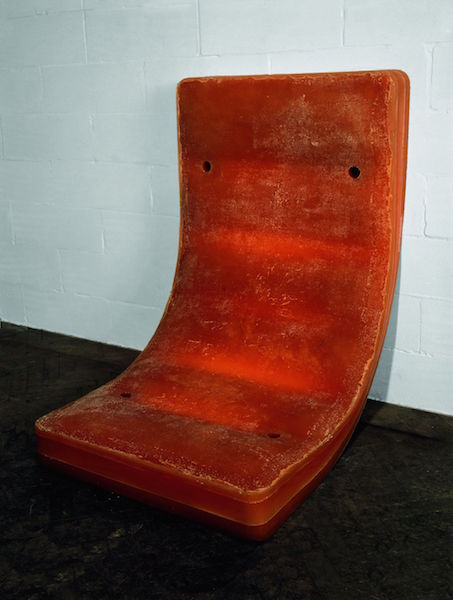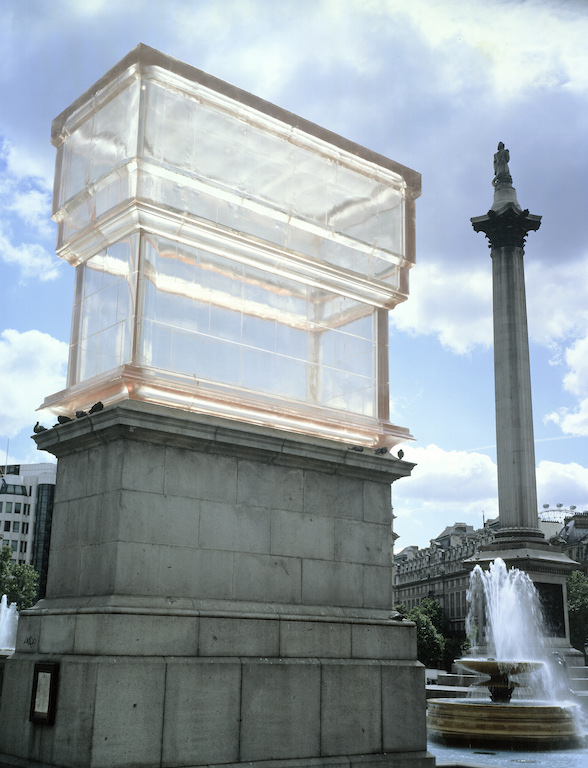Imagine Rachel Whiteread: Ghosts in the Room, BBC Two review - making memories solid | reviews, news & interviews
Imagine... Rachel Whiteread: Ghosts in the Room, BBC Two review - making memories solid
Imagine... Rachel Whiteread: Ghosts in the Room, BBC Two review - making memories solid
A revealing encounter with the shy artist who has so often made the headlines

Eureka! A programme about a woman artist that doesn’t define her as a wife and mother first and an artist second.
The beginning was horribly predictably, though. First we saw footage of the Turner Prize ceremony in 1993, when Whiteread became the first woman to win the £20,000 award. Earlier that year she made a concrete cast of a house in Bethnal Green, that was earmarked for demolition. House (pictured below right) sparked a media frenzy; cue television coverage of its unveiling and the man who had lived in the house denouncing the sculpture as “a waste of money... just a load of concrete.”
 Return to the moment in the Turner Prize ceremony when Whiteread was summoned outside to receive a protest prize of £40,000, awarded by the K Foundation (which she gave away). At this point my heart sank; yet another shock-horror doc, I thought, about contemporary art and the war of words whipped up by the media.
Return to the moment in the Turner Prize ceremony when Whiteread was summoned outside to receive a protest prize of £40,000, awarded by the K Foundation (which she gave away). At this point my heart sank; yet another shock-horror doc, I thought, about contemporary art and the war of words whipped up by the media.
But the mood quickly changed, with Whiteread sitting in her studio with Alan Yentob. I know from experience how difficult she is to interview because of her reserve; Yentob made her laugh, though, by pointing out that she won twice as much for being designated the worst artist in the world as for being the best artist in Britain. “I’m surprised you’re still with us,” he quipped. The comment turned out to be remarkably apposite, since Whiteread revealed she had a mini breakdown once House was demolished and the fuss had died down.
What followed was a sympathetic and insightful look at the work and Whiteread’s motivation for making it. In 1988 she made a plaster cast of the interior of a wardrobe and covered it in black felt to evoke the comforting darkness she remembers from when, as a child, she hid in her parents’ wardrobe. “It felt right,” she explained of the work. “I’d found my place; I’d somehow managed to make memories solid.”
 And, in one way or another, she has been making memories solid ever since. Among the childhood recollections that feed into her work are helping her father lay a concrete floor in her mother’s studio – she has since made casts of various floors. When her father lay dying, by way of a memorial she made a cast of the underside of a bed titled Shallow Breath (pictured left: Untitled (Amber Bed), 1991). Then came Ghost, the plaster cast of a room like those in her childhood home, followed by House, which turned an entire dwelling into a memorial.
And, in one way or another, she has been making memories solid ever since. Among the childhood recollections that feed into her work are helping her father lay a concrete floor in her mother’s studio – she has since made casts of various floors. When her father lay dying, by way of a memorial she made a cast of the underside of a bed titled Shallow Breath (pictured left: Untitled (Amber Bed), 1991). Then came Ghost, the plaster cast of a room like those in her childhood home, followed by House, which turned an entire dwelling into a memorial.
Soon after, Whiteread was invited to create a holocaust memorial for Judenplatz in Vienna. Concrete casts of hundreds of books created an impenetrable library; but the design provoked opposition both from the far right and the Jewish community, and it took five years of wrangling before the sculpture was completed. “I never intended to become an artist that made public monuments; it just happened that way,” Whiteread remarked ruefully. “You have to be emotionally equipped to do something like that. It takes a lot out of you and can leave big scars.” Not surprisingly, when she created a sculpture for the fourth plinth in Trafalgar Square in 2001 (pictured below), it was resolutely devoid of content. A resin cast of the empty plinth, it questioned what or whom we might collectively agree to celebrate.
Meanwhile, she continued to make sculptures that were deeply personal. In Embankment, an installation created for Tate Modern in 2005, she paid tribute to her mother Pat, who was also an artist. Hundreds of boxes cast in white polythene occupied the Turbine Hall; their sepulchral presence recalled the mountain of boxes that she filled with possessions from the family home after her mother died.
 Whiteread’s most recent work memorialises her own career. To produce the papier maché used in Wall/Door, for instance, she shredded the morass of correspondence generated by House. Wall/Door was cast from a shed and refers to a series of concrete sheds located in out-of-the-way places, which she refers to as Shy Sculptures. In a sense they are self-portraits, and it is no surprise to learn that the artist has recently left London to live in an undisclosed location a long way from the hassle her work has often provoked.
Whiteread’s most recent work memorialises her own career. To produce the papier maché used in Wall/Door, for instance, she shredded the morass of correspondence generated by House. Wall/Door was cast from a shed and refers to a series of concrete sheds located in out-of-the-way places, which she refers to as Shy Sculptures. In a sense they are self-portraits, and it is no surprise to learn that the artist has recently left London to live in an undisclosed location a long way from the hassle her work has often provoked.
The programme ended with Whiteread wistfully standing in the spot once occupied by House. Yentob was nowhere to be seen; thankfully, he remained relatively unobtrusive throughout, only putting in one gratuitous appearance – peering through the glass wall of New York’s Museum of Modern Art at a rooftop sculpture by the artist. Maybe he, too, has learned that it's better to stay out of the spotlight.
rating
Explore topics
Share this article
Add comment
The future of Arts Journalism
You can stop theartsdesk.com closing!
We urgently need financing to survive. Our fundraising drive has thus far raised £49,000 but we need to reach £100,000 or we will be forced to close. Please contribute here: https://gofund.me/c3f6033d
And if you can forward this information to anyone who might assist, we’d be grateful.

Subscribe to theartsdesk.com
Thank you for continuing to read our work on theartsdesk.com. For unlimited access to every article in its entirety, including our archive of more than 15,000 pieces, we're asking for £5 per month or £40 per year. We feel it's a very good deal, and hope you do too.
To take a subscription now simply click here.
And if you're looking for that extra gift for a friend or family member, why not treat them to a theartsdesk.com gift subscription?
more TV
 Murder Before Evensong, Acorn TV review - death comes to the picturesque village of Champton
The Rev Richard Coles's sleuthing cleric hits the screen
Murder Before Evensong, Acorn TV review - death comes to the picturesque village of Champton
The Rev Richard Coles's sleuthing cleric hits the screen
 Black Rabbit, Netflix review - grime and punishment in New York City
Jude Law and Jason Bateman tread the thin line between love and hate
Black Rabbit, Netflix review - grime and punishment in New York City
Jude Law and Jason Bateman tread the thin line between love and hate
 The Hack, ITV review - plodding anatomy of twin UK scandals
Jack Thorne's skill can't disguise the bagginess of his double-headed material
The Hack, ITV review - plodding anatomy of twin UK scandals
Jack Thorne's skill can't disguise the bagginess of his double-headed material
 Slow Horses, Series 5, Apple TV+ review - terror, trauma and impeccable comic timing
Jackson Lamb's band of MI5 misfits continues to fascinate and amuse
Slow Horses, Series 5, Apple TV+ review - terror, trauma and impeccable comic timing
Jackson Lamb's band of MI5 misfits continues to fascinate and amuse
 Coldwater, ITV1 review - horror and black comedy in the Highlands
Superb cast lights up David Ireland's cunning thriller
Coldwater, ITV1 review - horror and black comedy in the Highlands
Superb cast lights up David Ireland's cunning thriller
 Blu-ray: The Sweeney - Series One
Influential and entertaining 1970s police drama, handsomely restored
Blu-ray: The Sweeney - Series One
Influential and entertaining 1970s police drama, handsomely restored
 I Fought the Law, ITVX review - how an 800-year-old law was challenged and changed
Sheridan Smith's raw performance dominates ITV's new docudrama about injustice
I Fought the Law, ITVX review - how an 800-year-old law was challenged and changed
Sheridan Smith's raw performance dominates ITV's new docudrama about injustice
 The Paper, Sky Max review - a spinoff of the US Office worth waiting 20 years for
Perfectly judged recycling of the original's key elements, with a star turn at its heart
The Paper, Sky Max review - a spinoff of the US Office worth waiting 20 years for
Perfectly judged recycling of the original's key elements, with a star turn at its heart
 The Guest, BBC One review - be careful what you wish for
A terrific Eve Myles stars in addictive Welsh mystery
The Guest, BBC One review - be careful what you wish for
A terrific Eve Myles stars in addictive Welsh mystery
 theartsdesk Q&A: Suranne Jones on 'Hostage', power pants and politics
The star and producer talks about taking on the role of Prime Minister, wearing high heels and living in the public eye
theartsdesk Q&A: Suranne Jones on 'Hostage', power pants and politics
The star and producer talks about taking on the role of Prime Minister, wearing high heels and living in the public eye
 King & Conqueror, BBC One review - not many kicks in 1066
Turgid medieval drama leaves viewers in the dark
King & Conqueror, BBC One review - not many kicks in 1066
Turgid medieval drama leaves viewers in the dark
 Hostage, Netflix review - entente not-too-cordiale
Suranne Jones and Julie Delpy cross swords in confused political drama
Hostage, Netflix review - entente not-too-cordiale
Suranne Jones and Julie Delpy cross swords in confused political drama

Comments
Loved the documentary. Love
what is that music ...?
Aghhhh!!! Me too. Please post
the humming song is
Me also! Would love to know
Artist: Tibor Szemzo
thank you so much to giving